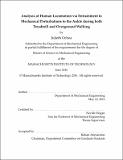Analysis of human locomotion via entrainment to mechanical perturbations to the ankle during both treadmill and overground walking
Author(s)
Ochoa, Julieth
DownloadFull printable version (4.726Mb)
Other Contributors
Massachusetts Institute of Technology. Department of Mechanical Engineering.
Advisor
Neville Hogan.
Terms of use
Metadata
Show full item recordAbstract
Rehabilitation of human motor function is an issue of utmost significance affecting millions of Americans. Robot-aided therapy emerged as a promising method to meet the increasing demand for effective rehabilitation services. While robot-aided therapy for upper-extremity provides clinically-proven, efficient rehabilitation, human-interactive robots for lower-extremity therapy have been substantially less successful. Given the labor-intensive nature of conventional, human-administered walking therapy, effective robot-aided assistance is urgently needed. The use of robots and treadmills that may inadvertently suppress the expression of the natural oscillatory dynamics of walking is addressed in this thesis as a possible explanation for the ineffectiveness of robotic walking therapy. To further investigate the natural oscillatory dynamics of walking, the existence and provenance (spinal or central) of a neuro-mechanical oscillator underlying human locomotion was assessed. This oscillator was studied via gait entrainment to periodic mechanical perturbations at the ankle in both treadmill and overground environments. Experiments with unimpaired human subjects provided direct behavioral evidence of the non-negligible contribution to human walking made by a limit-cycle oscillator in the spinal neuro-mechanical periphery. Entrainment was always accompanied by phase-locking so that plantar-flexion perturbations assisted propulsion during ankle 'push-off' while dorsi-flexion perturbations assisted toe-clearance during 'initial swing'. The observed behavior seemed to require a neural adaptation that could not easily be ascribed to biomechanics, suggesting a hierarchical organization between the supra-spinal nervous system and the spinal neuro-mechanical periphery: episodic supervisory control.
Description
Thesis: S.M., Massachusetts Institute of Technology, Department of Mechanical Engineering, 2016. This electronic version was submitted by the student author. The certified thesis is available in the Institute Archives and Special Collections. Cataloged from student-submitted PDF version of thesis. Includes bibliographical references (pages 94-104).
Date issued
2016Department
Massachusetts Institute of Technology. Department of Mechanical EngineeringPublisher
Massachusetts Institute of Technology
Keywords
Mechanical Engineering.